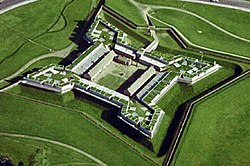Our website is made possible by displaying online advertisements to our visitors.
Please consider supporting us by disabling your ad blocker.
Siege of Fort Stanwix
| Siege of Fort Stanwix | |||||||
|---|---|---|---|---|---|---|---|
| Part of the American Revolutionary War | |||||||
 Aerial view of the reconstructed Fort Stanwix | |||||||
| |||||||
| Belligerents | |||||||
| Commanders and leaders | |||||||
| Strength | |||||||
|
| ||||||
| Casualties and losses | |||||||
|
| ||||||
The siege of Fort Stanwix (also known as Fort Schuyler) began on August 2, 1777, and ended on August 22, 1777. Fort Stanwix, at the western end of the Mohawk River Valley, was a primary defense point for the Continental Army against the British and indigenous forces aligned against them during the American Revolutionary War. The fort was occupied by Continental Army forces from New York and Massachusetts under the command of Colonel Peter Gansevoort. The besieging force was composed of British regulars, Loyalist soldiers, Hessians, and indigenous warriors, under the command of Brigadier General Barry St. Leger. St. Leger's expedition was a diversion in support of Lieutenant General John Burgoyne's campaign to take control of the Hudson River Valley to the east.
One attempt at relief was thwarted early in the siege when a force of New York militia under Brigadier General Nicholas Herkimer was ambushed on August 6 at the Battle of Oriskany by a large detachment of St. Leger's forces. While the battle did not involve the fort's garrison, some of its occupants sortied and plundered the nearly empty indigenous and Loyalist camps, which was a blow to the morale of St. Leger's indigenous allies. The siege was finally broken when American reinforcements under the command of Major General Benedict Arnold approached, and Arnold used a ruse to convince the besiegers that he had a much larger force. This misinformation, combined with the departure of many of the indigenous warriors, led St. Leger to abandon the effort and withdraw.
St. Leger's failure to advance on Albany contributed to Burgoyne's surrender following the Battles of Saratoga in October 1777. Although St. Leger reached Fort Ticonderoga with some of his forces in late September, he was too late to aid Burgoyne.
- ^ British casualties are as reported by St. Leger in Watt (2002), pp. 320–321, which include casualties from Oriskany. Watt notes that St. Leger did not report Canadien casualties, and probably under-reported some British casualties.
- ^ Cite error: The named reference
Watt258was invoked but never defined (see the help page).
Previous Page Next Page


